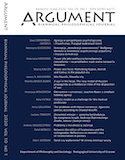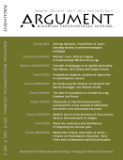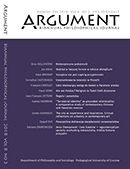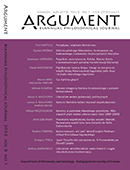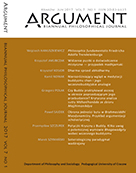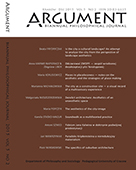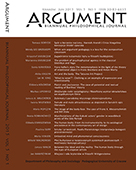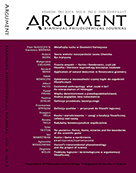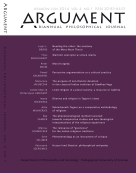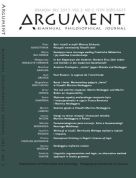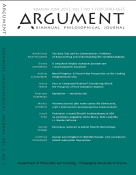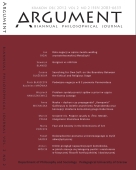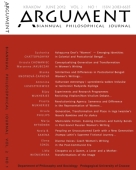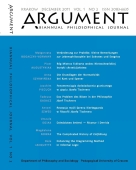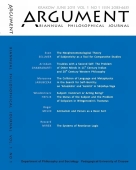Argument: Biannual Philosophical Journal publishes contributions in the following sections:
- Articles and treatises: maximum number of words 7,000 (c. 40,000 letters & spaces) and minimum 3,500 (c. 20,000 letters and spaces). Please list full word count including references and bibliography.
- Polemics, debates, interviews, polemical book reviews, translations into Polish, papers on teaching philosophy, obituaries and memories, essays “through philosOFFer’s lens”, etc.: maximum 3,500 words (c. 20,000 letters & spaces).
- Reports, commentaries, book notes, etc.: maximum 1,500 words (c. 4,000 letters & spaces)
- Announcement and invitations: maximum 300 words (c. 1,800 letters & spaces)
All contributions (MS Word) can be submitted to the address: argument.journal@gmail.com
Along with her or his submission the author is required to send a signed copyright declaration.
___________________________________________________________________________________________
Ethical principles. When submitting the paper and a signed copyright declaration form to the Editors of the Argument: Biannual Philosophical Journal:
- Author formally declares his or her authorship of the study design and originality of the interpretation presented in the text, as well as one’s own literature or data search, and indicates the source of funding (if different than the author’s institution of present affiliation).
- The submission of one’s paper and the above declaration also implies that the Author’s copyright is granted voluntarily (free of charge) to the journal for publishing this paper online and in print, whereas the Editors declare to make effort of promoting the journal contents and archiving it in the allied repositories, indexing databases, and the relevant websites supporting the journal’s activity.
- In case of co-authorship, co-operation or any form of engagement of other subjects in the manuscript preparation (including the assumptions, objectives, topic range, selection of methods, translation, etc.), the submitting Author is obliged to report it and insert a suitable acknowledgement or reference (preferably, specifying contribution of each author in percentages).
Thus, the Editors actively seek to prevent any unfair, biased and unethical practices, such as ghostwriting, guest writing, and plagiarism by consulting the online databases and anti-plagiarism scanning. All detected cases of unreliability and dishonesty will result in notification of the relevant subjects (i.e. academic institution employing the Author, scientific societies, editors of other journals, etc.).
The Editors accept to publish corrections, clarifications, retractions and apologies when needed. We do not charge the Authors for publishing their scholarly papers, responses and reviews in the journal.
The Editors strive to meet the high standards defined in the Code of Conduct and Best Practice Guidelines for Journal Editors promoted by the Committee on Publication Ethics (COPE) .
___________________________________________________________________________________________
Reviewing procedure. Every submitted paper undergoes the following procedure described below. The final decision about acceptance or rejection of the paper is usually taken within eight weeks after submission (unless the reviewing procedure is prolonged due to the reasons beyond the control of the Editors). Authors are updated throughout the process whenever required. Our reviewing procedure is transparent and includes the following steps:
- The editors check the submission to judge whether it respects the academic, ethical and editorial standards and has some chance of ultimately being accepted.
- The submitted paper is given an ID number which replaces the name of the author on the next steps of the reviewing process.
- The editors select and invite two external reviewers being the specialists in the field to review the submission.
- The evaluators are asked to supply their reports within four weeks. The review is prepared according to the criteria specified in the form provided by the editors, which makes the evaluation clear and conclusive. When agreeing to assess the paper the reviewer should admit there is no conflict of interest with respect to the research, the authors and/or the research funders (by “conflict of interest” we understand: (1) family relationship, (2) close professional relationship, (3) professional cooperation within two years before the review is prepared).
- The overall evaluation of the paper depends on meeting the following criteria: (1) subject area of the paper fits well to the profile of the journal and/or the leading theme of the volume; (2) paper is original, insightful, and it reveals a new aspect of the issue under question, it is thought-provoking, invites polemics and/or can inspire further research in the field; (3) paper discusses the subject matter diligently and thoroughly, it can serve as a good introduction to the issue under question, has a didactic value; (4) bibliography used in the paper is sufficient, it covers the most essential and up-to-date publications corresponding to the subject matter; (5) paper is well written, in good style proper for academic publications. Each decision on a submission falls into one of the following 4 categories:
Accepted – paper is unanimously recommended for publication in the present form or after some minor corrections suggested by the editors and/or reviewers.
Accepted with requirement of some revisions – paper is recommended for publication only after making some corrections and improvements according to the directions given by the editors and/or reviewers.
Conditionally accepted – paper is recommended for publication conditionally after correcting and re-editing it thoroughly according to the directions given by the editors and reviewers. A reconsideration by the reviewer may be needed.
Rejected – paper is not recommended for publication. It contains some major mistakes or serious shortcomings and needs profound restructuring before it is, possibly, resubmitted.
- Once the reviews have been received, the conclusion is sent to the corresponding author by email with the possible suggestions and criticisms serving to improve the submitted material (normally the corrections should be made within 1 week).
- If the reviewers have no objections to the submission and when the author has complied with the requirements of the editors, the submitted paper is ultimately accepted for publication in the particular issue of the journal.
The prospective authors are kindly asked to conform to these FORMAT GUIDELINES:
- The languages accepted for publication are: English, German and Polish.
- Articles submitted for publication in Argument: BPJ should be addressed to: argument.journal@gmail.com. In order that manuscripts may be blind-reviewed (i.e. read in ignorance of authorship), we request that names of authors and their institutional affiliations not appear on manuscripts or the electronic copy.
- The list of references (full bibliography), including both the primary and secondary sources, should be enclosed at the end of the paper. For details see below.
- An abstract of 200–250 words at the beginning of the paper is required, as well as a few keywords.
- The summary should have a structured form, i.e. reflect structure of an article (background, material and methods, results, conclusion).
- Key words should not repeat the title of the manuscript.
- Do attach in a separate file one-paragraph author’s bio (academic degree, affiliation, main interests and titles of recent publications, etc.).
- Author’s current postal address.
- All contributions should be written in MS-Word; Font: Times New Roman, 12 point (for the main text) and 10 point (for the footnotes); spacing: 1,5 for the main text, or 1,0 for the footnotes and for extended (40 words or longer) quotations, which should be inset and single-spaced. Margins: 1 inch margins on all sides Justification: full justification; turn off the hyphenation option in your software to avoid end-of-line hyphens.
- Persons (authors, editors, etc.) referred to in the paper for the first time should be mentioned with their full first name. In subsequent occurrences and in bibliography use initials only (e.g., J.P. Smith).
- Quotation: use ‘single quotation marks’ to set off quotations within the text, and “use double quotation marks” to set off quotations within quotations. When citing sources both in the body of the text and in the footnotes, use short form citations, e.g. … in Smith (2004: 265)… or … (Smith, 2004: 265). If you refer to the source to compare only, use: (e.g. Smith, 2004).
- For longer comments use footnotes. Footnotes, when used, should contain only substantive information. Bibliographic citation should be in-line (see below for examples). Note indicators are superscripted arabic numbers without parentheses.
- Titles: Book titles are italicised; article titles are enclosed in quotation marks if mentioned in the body of the text (but skip quotation marks in Bibliography). Conference titles are in quotation marks, not italics.
- Foreign Language Issues: all technical terms in Latin, Greek, Sanskrit, Chinese, French, etc., except proper names, are italicised.
- Use a font that contains characters with the necessary diacritical marks. We recommend Times Roman Transliteration.
- Follow British spelling, for example for words ending in -ise/-ize use -ise. The -yse form for such words as ‘analyse’ is the only correct spelling in British English. Also use British punctuation style: commas, full stops, semi-colons, question marks and exclamation marks fall within quotation marks only if they are part of the quoted material.
- Main headings are CAPITALISED, and the sub-heading s p a c e d.
- Any terms or phrases emphasised by the author are s p a c e d (NOT italicised or boldfaced).
- Grammar: ‘That’ to be used only in restrictive relative clauses; ‘which’ to be used in descriptive relative clauses. ‘Since’ to be used only with reference to a passed period of time, not as a synonym of ‘because’; ‘while’ to be changed to ‘although’ when not used specifically in terms of a time relationship.
- Numbers: Numbers one to ninety-nine are written out; numbers 100 and over are in numerals (but 36 percent). No elision of numbers: pages 232–238, not 232–38; 1980–1984, not 1980–84. Chapter one, chapter two, etc., not chap. 1 or chapter 1.
- Dates: 1500s, not 1500’s.; 1960s, not sixties; seventh century, not Seventh Century or 7th Century; 650 B.C., A.D. 1998, 621 B.C.E. (B.C.E. and C.E. are preferred to B.C. and A.D.); March 5, not March 5th.
- Bibliographic reference in text: citations of sources are separated from text by a space, with author’s last name, coma, date of the publication, colon, page numbers within parentheses. Examples: (Smith, 1976: 43); (Thompson, Cannon & Narr, et al., 2001); (e.g., Spinger, 2005: 331–352).
- Bibliography (to be attached at the end of the paper; all articles, chapters, books, web-sites or other cited materials should be listed alphabetically):
- Book:
- Ryle, G. (1949). The concept of mind. London: Hutchinson.
- Goetz, S. & Tallaferro, C. (2011). A brief history of the soul. Oxford: Wiley-Blackwell.
- Translated book or a part of the book:
- Kant, I. (1958). Critique of pure reason. (N. Kemp Smith, Trans.). New York: The modern library.
- Yogasūtra (1989). In: The Yoga-Sūtra of Patañjali. A new translation and commentary. (G. Feuerstein, Trans.). Rochester: Inner Traditions International.
- Edited volume:
- Wolf, L. M. (Ed.). (1968). Philosophy and science. New York: Guilford Press.
- Thompson, D., Carr, T. D., & Raine, K. L., et al. (Eds.). (2003). Ethical issues. Albany: State University of New York Press.
- Multivolume work, encyclopedia or dictionary:
- Wiener, P. (Ed). (1973). Dictionary of the history of ideas (Vols. 1–4). New York: Charles Scribner’s Sons.
- Posner, R. (1987). Romance languages. In: The encyclopedia Britannica: Macropedia (15th ed.).
- Chapter (or preface, afterword, etc.) in a book or edited volume:
- Swinburn, R. (1980). Properties, causation, and projectibility: Reply to Shoemaker (pp. 313–320). In: L. J. Cohen & M. Hesse (Eds.). Applications of inductive logic. Oxford: Clarendon Press.
- Duncan, H. D. (1984). Introduction (xiii–xiv). In: K. Burke. Permanence and change: An anatomy of purpose. Berkeley: University of California Press.
- Scholarly journal article or review (with doi or without, accessible in print or online):
- Patton, L. L. (2011). Traces of Śaunaka: A literary assessment. Journal of the American Academy of Religion, 79(1), 113–135. doi: 10.1093/jaarel/lfq062
- Schmitz, H. (2004). The ‘new phenomenology’. In: A. T. Tymieniecka (Ed.). Phenomenology world-wide (= Analecta Husserliana, 47), 491–494.
- Elżanowski, A. (2013). Moral progress. Argument: Biannual Philosophical Journal, 3(1), 13-25. Retrieved from: http://argumentwp.vipserv.org/wp-content/uploads/2013/pdfv3n1/argument_v3n1_Elzanowski.pdf (20.11.2014).
- Harris, S. (2011). Does anātman rationally entail altruism? On Bodhicaryāvatāra. Journal of Buddhist Ethics, 18, 93–123. Retrieved from: http://blogs.dickinson.edu/buddhistethics/files/2011/02/Harris_AnatmanAltruism1.pdf (15.03.2014).
- Cook, T. I. (1951). [Review of H. Arendt (1951). The origins of totalitarianism. New York: Schocken Books]. Political Science Quarterly, 66(2), 290–293.
- Magazine or daily newspaper:
- Poniewozik, J. (2000, November 20). TV makes a too-close call. Time, 156(21), 70–71.
- Krugman, A. (2007, May 21). Fear of eating. New York Times, p. A1.
- Image from a website:
- Goya, F. (1800). The family of Charles IV. Museo National del Prado. Retrieved from http://www.metmuseum.org/toah/hd/goya/hd_goya.htm (20.04.2013).
- Book:
How to prepare the blinded manuscript
Submit two WORD files. Apart from a full paper, the author is also asked to submit a blinded manuscript. Besides the obvious need to remove names and affiliations under the title within the manuscript, there are other steps that need to be taken to ensure the manuscript is correctly prepared for double-blind peer review. To assist with this process check the key items that need to be observed in your blinded submission:
- use the third person to refer to work the author has previously undertaken, e.g. replace any phrases like “as I have shown before” with “as it has been shown before (anonymous, 2012: 246)”
- make sure figures do not contain any affiliation related identifier
- do not eliminate essential self-references or other references but limit self-references only to papers that are relevant for those reviewing the submitted paper
- cite papers published by the author in the text as follows: “anonymous (2012: 234)”
- for blinding in the bibliography: “Anonymous (2012). details omitted for double-blind reviewing”
- remove references to funding sources
- do not include acknowledgements

